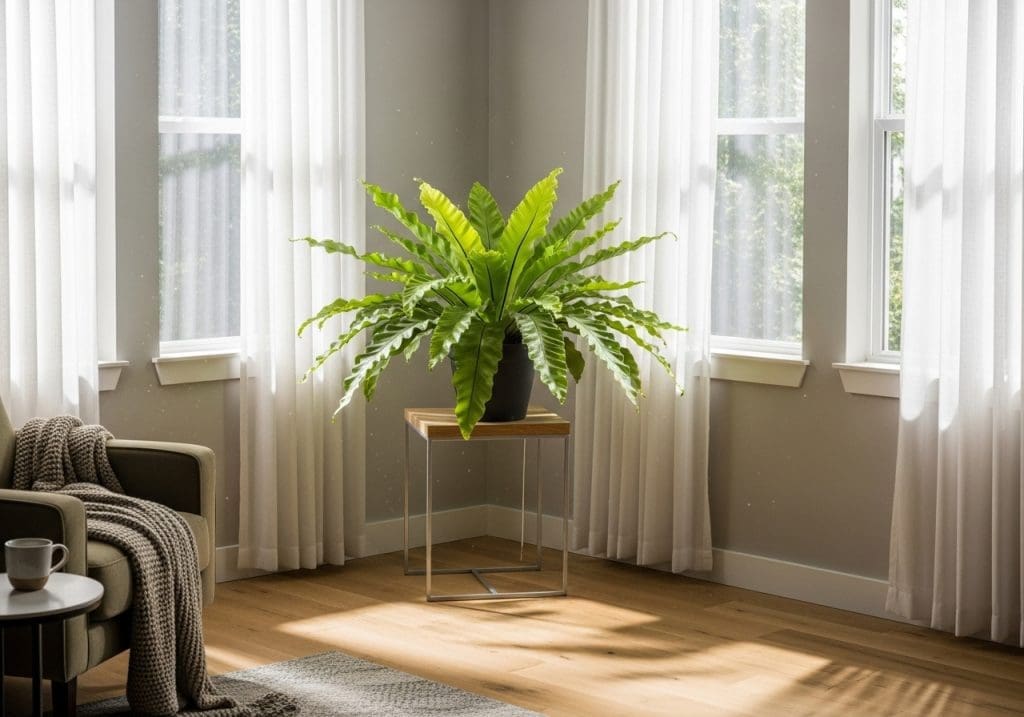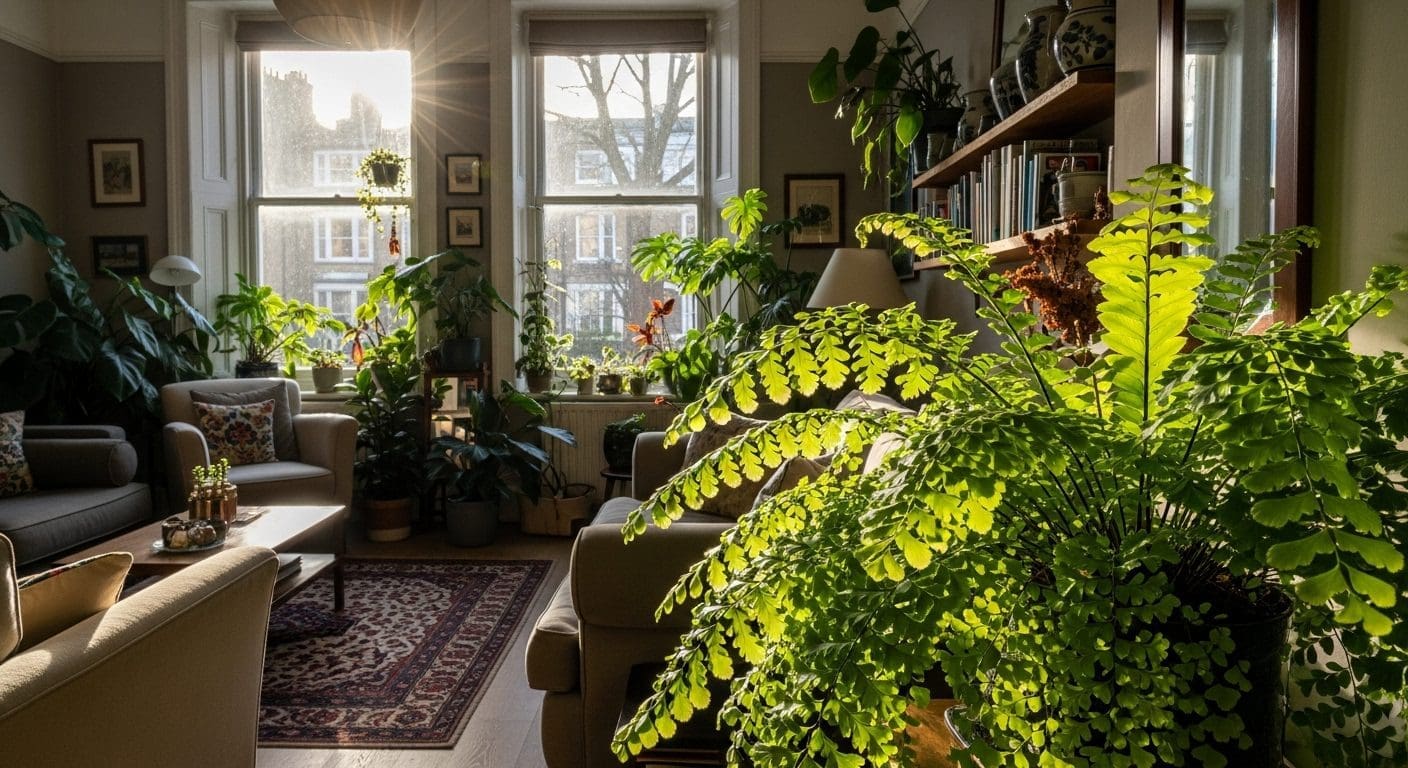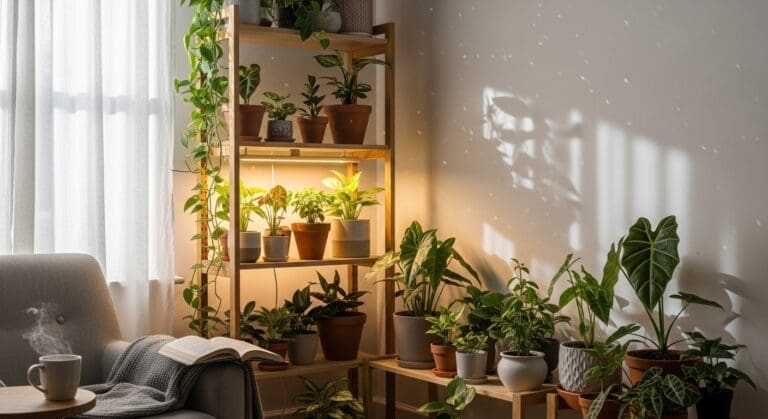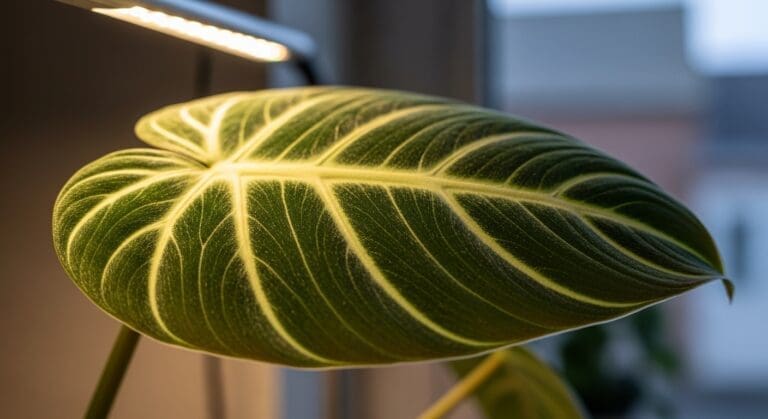If you’ve ever tried to keep a fern alive in your home, you’ve probably heard the term “bright indirect light” more times than you can count. But what does it actually mean? And more importantly — how can you tell if your fern is getting the right amount?
For fern lovers, understanding light is just as crucial as watering. In fact, I often say, “You can save an underwatered fern, but not one that’s been sitting in the wrong light for months.”
In this guide, we’ll break down bright indirect light into measurable numbers (lux and foot-candles), show you how to test it with your phone, and help you create a space where your fern can truly thrive.
What “Bright Indirect Light” Means for Ferns
In plant care terms, bright indirect light means your fern receives plenty of ambient light without the harsh rays of the sun directly hitting its leaves. Think of it as filtered daylight — strong enough to fuel photosynthesis, but gentle enough to avoid leaf burn.
For indoor gardeners, especially those with delicate species like Maidenhair or Bird’s Nest ferns, bright indirect light is a sweet spot that prevents fading, scorching, and stress.
💡 If you’re new to light levels in plant care, you can read more in our understanding bright indirect light in indoor gardening guide, which dives deeper into the science behind indoor lighting.
Lux & Foot-Candles: Making Light Measurable
While “bright indirect” sounds poetic, plants don’t speak poetry — they respond to measurable energy. This is where lux and foot-candles (FC) come in.
- Lux measures the intensity of light perceived by the human eye.
- Foot-candles are the imperial version, often used in horticulture in the US (1 FC ≈ 10.76 lux).
Ideal range for ferns:
- Lux: 5,000–10,000
- Foot-candles: 500–1,000
These numbers give you a concrete target, so you’re not guessing whether your fern’s spot is “bright enough.”

The Phone-Lux Test
You don’t need fancy horticultural tools to measure light. Your smartphone’s light meter app can give you a surprisingly accurate reading.
How to test:
- Download a lux meter app (like “Lux Light Meter” for iOS or “Light Meter” for Android).
- Place your phone where your fern sits, sensor facing the window.
- Note the lux reading at different times of day.
If your fern’s spot averages between 5,000 and 10,000 lux during daylight hours, you’re in the safe zone.
“When I first tested my fern’s corner, I was shocked to see it was barely 2,000 lux — no wonder it looked sad.”

Finding the Perfect Spot
Different rooms and orientations create very different light conditions:
- East-facing windows often give the best bright indirect light — gentle morning sun, bright midday light.
- North-facing windows in the UK and US tend to be dimmer, so you may need to move the plant closer or supplement with grow lights.
- South- and west-facing windows can be too intense — use sheer curtains to filter the light.
For city apartments, a bright corner two to three feet away from a large window often works best.

Tips for Adjusting Light
If your fern’s leaves look pale or it’s losing fronds, it might not be getting enough light.
If they develop crispy edges, it might be too much.
Quick fixes:
- Move the plant closer to the window (but not into direct sun).
- Add a full-spectrum LED grow light for 8–10 hours daily.
- Use light-colored walls or mirrors to reflect natural light.
Expert Insight
According to Dr. Laura Jenkins, horticulturist at the Royal Botanic Gardens, Kew:
“Ferns evolved in the understory of forests, where light is abundant but diffused. Replicating this balance indoors is the key to keeping them lush and healthy.”
The Royal Horticultural Society also emphasizes that proper light is just as critical as watering for indoor ferns.
Rhetorical Check-Ins
- Have you ever wondered why your fern thrives in summer but struggles in winter?
- Is that corner bookshelf really the best spot, or is it a low-light trap?
- Could your plant’s slow growth be a simple light issue rather than a nutrient problem?
These are the questions every fern lover should ask before blaming themselves for “bad plant parenting.”
Seasonal Adjustments
In the UK and northern US, winter daylight hours drop significantly. Even a bright east window might not provide enough lux.
Winter care tip: Move your fern closer to the window, remove heavy curtains, and consider temporary grow light support.

Light is the invisible lifeline of your fern. Once you understand and measure it, you’ll see a transformation in your plant’s health and resilience.
“Since I started using a lux meter, I’ve stopped guessing and started growing.”

RarePlantCare Editorial Team produces expert content on rare plants.
Our articles are AI-assisted and human-edited before publication.
We aim to provide practical, evidence-based guides for plant lovers worldwide.
Learn more about our Editorial Policy





